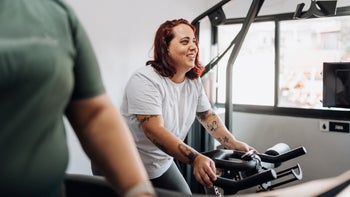
7 Benefits of Pull-Ups to Maximize Your Strength-Training Routine
Key takeaways:
Pull-ups offer an upper body workout, targeting muscles from the arms to the core and back.
Incorporating pull-ups into your routine can strengthen muscles, improve posture, and support strong bones.
Pull-ups are a convenient and effective exercise, and don’t need much equipment to do.

Pull-ups are more than just a challenging exercise. They're a gateway to a stronger, fitter upper body. Whether you're a seasoned gym-goer or a beginner, incorporating pull-ups into your strength-training routine can yield a host of benefits.
Learn why pull-ups are the ultimate upper body workout and how they can help you achieve your fitness goals.
What are the benefits of doing pull-ups?
A pull-up challenges you to lift your body while holding a horizontal pull-up bar. From building muscle to improving grip strength, pull-ups can take your fitness to the next level. Let's delve into the top benefits of pull-ups.
Search and compare options
1. Pull-ups strengthen upper body and core muscles
Pull-ups target multiple muscle groups to strengthen upper body and core muscles, including the following:
Back: Pull-ups are a great way to strengthen back muscles. The exercise mainly works the latissimus dorsi (lats) in your upper back. But it also engages muscles such as the rhomboids and trapezius.
Arms: Your arms, especially the biceps, get a good workout as you lift and lower your body during each pull-up repetition.
Shoulders: Pull-ups activate shoulder muscles, particularly the deltoids. Your rear deltoids help stabilize your shoulders during each pull-up. Your rotator cuff muscles help your arms externally rotate at the top of the pull-up.
Core: You engage core muscles, including the abdominals, to stabilize your body as you pull up and lower down.
2. Pull-ups increase grip strength
You use an overhand grip to hold a bar during pull-ups, which can improve your hand grip strength.
A firm grip is useful for more than daily activities like opening stubborn jars. It can also help with athletic performance in sports such as baseball, golf, and rock climbing. In addition, grip strength may be an indicator of your overall health and strength.
3. Pull-ups build muscle mass
If you want to build muscle, the pull-up is your friend. Strength-training exercises, like pull-ups, are proven to increase muscle mass and even reverse age-related muscle loss. This is crucial for maintaining strength and functionality as you get older.
4. Pull-ups change body composition
Strength-training exercises like pull-ups can do wonders for your body composition. Your body composition is the amount of muscle, bone, and fat in your body. Studies have shown that regular strength training helps burn fat, improve insulin sensitivity, and reduce the risk of heart disease, especially when combined with regular cardio workouts.
Read more like this
Explore these related articles, suggested for readers like you.
The key is to create a resistance training plan that includes at least two muscle-strengthening workouts per week. Exercises should target upper and lower body muscles.
5. Pull-ups support strong bones
Research shows that bone density peaks around age 30 and then naturally starts to decline. So maintaining strong bones is increasingly important as you age. It can reduce the risk of falls, broken bones, and osteoporosis.
Resistance exercises like pull-ups put healthy stress on your bones, which can help them get stronger. Strength training has been shown to increase bone density, particularly in older adults. In one study, sedentary adults who strength trained saw a 3% increase in their bone density after just 10 weeks.
6. Pull-ups improve posture
Maintaining good posture keeps your body aligned. It also helps prevent injuries and boost your confidence.
Strengthening your back and core muscles with pull-ups may lead to better posture. That's because stronger muscles can help you keep your shoulders back and your spine neutral when you sit or stand. Try adding pull-ups and other posture-correcting exercises to your weekly fitness routine.
7. Pull-ups boost athletic performance
If you're an athlete looking to up your game, pull-ups can help. Studies have shown that athletes who practice sports like Brazilian jiu-jitsu and kickboxing can benefit from adding pull-ups into their training regimen.
Pull-ups can also help with sports that involve pulling or gripping, such as lifting, rowing, and tennis.
Getting stronger is tough. But these science-backed tips to build muscle mass can help.
There’s good news if you're starting a new strength-training plan after a break. Research suggests that muscle memory may help you bounce back faster.
Hand grip strength is an important indicator of health and fitness. Try these exercises for a firmer grip.
How to do a pull-up
Pull-ups may seem intimidating at first. But you can master them with the proper technique. You'll need a secure pull-up bar high enough to hang from without your feet touching the floor. Beginners can practice with an assisted pull-up machine at the gym.
Step 1: Stand under the pull-up bar with your feet shoulder-width apart.
Step 2: Extend your arms overhead with your palms facing away from you to reach for the pull-up bar. You may need to jump to grab the bar, depending on how high it is. Your hands should be slightly wider than shoulder-width apart while you maintain an overhead grip on the bar.
Step 3: Engage your core as you hang from the bar with your arms fully extended.
Step 4: Exhale as you bend your elbows and lift yourself up toward the bar. You want your elbows to move down as your body lifts up. Pull up so your chin is at or just above the bar.
Step 5: Pause at the top of the pull-up before lowering yourself until your arms are fully extended.
Step 6: Complete the desired number of repetitions.
Tip: Avoid "kipping," or swinging your lower body to get to the top of the bar faster. This can destabilize your lower back and shoulders, increasing your risk of injury.
How often should you do pull-ups?
It depends on your fitness level and goals. Experts recommend doing two muscle-strengthening workouts per week. Experienced or advanced exercisers can add pull-ups to one or both of their weekly strength-training sessions. Try doing 1 to 3 sets of 1 to 6 pull-up repetitions to build upper-body strength. But include 2 to 3 active recovery days between workouts to avoid overworking the same muscles.
If you're a beginner who's not quite ready for full pull-ups yet, don't worry. There are plenty of pull-up modifications to help you build strength.
Inverted row
Also known as a horizontal pull-up, this exercise targets the same muscles as traditional pull-ups but in a more manageable position.
Step 1: Set up a sturdy bar at waist height with a Smith machine or a barbell in a rack. You can set the bar lower, at mid-thigh height, to increase the challenge.
Step 2: Lie underneath the bar with your legs extended and your heels touching the floor. Extend your arms and grasp the bar with your palms facing away from you and your hands shoulder-width apart.
Step 3: Pull your chest towards the bar, squeezing your shoulder blades together. Keep your body straight and your heels planted on the floor as you pull up.
Step 4: Slowly lower yourself back down to the starting position.
Lat pulldown
Mimic the movement of pull-ups using a lat pulldown machine to reduce resistance.
Step 1: Sit at a lat pulldown machine with your knees tucked under the pads and feet flat on the ground.
Step 2: Grasp the bar with palms facing away from you and your hands slightly wider than shoulder-width apart.
Step 3: Pull the bar down towards your chest, keeping your elbows close to your body and squeezing your shoulder blades together.
Step 4: Slowly release the bar back up to the starting position. Keep your torso upright, and avoid using momentum to complete the movement.
The bottom line
The many benefits of pull-ups make them an excellent addition to your strength-training routine. Practicing the exercise can lead to stronger upper-body muscles, better bone health, and improved athletic performance. Beginners who aren’t ready to perform pull-ups on a standing pull-up bar can reap similar benefits by performing a modified version of the exercise.
Why trust our experts?



References
ACE Fitness. (n.d). Back exercises: Seated lat pulldown. American Council on Exercise.
Ambroży, T., et al. (2022). Effect of CrossFit training on physical fitness of kickboxers. International Journal of Environmental Research and Public Health.
Atomic Athlete. (2021). Horizontal pull up [video]. YouTube.
Baxter-Jones, A. D. G., et al. (2011). Bone mineral accrual from 8 to 30 years of age: an estimation of peak bone mass. Journal of Bone and Mineral Research.
Centers for Disease Control and Prevention. (2024). What you can do to meet physical activity recommendations.
Ho, S. S., et al. (2012). The effect of 12 weeks of aerobic, resistance or combination exercise training on cardiovascular risk factors in the overweight and obese in a randomized trial. BMC Public Health.
Kim, S., et al. (2022). Effects of Twenty-Four Weeks of Resistance Exercise Training on Body Composition, Bone Mineral Density, Functional Fitness and Isokinetic Muscle Strength in Obese Older Women: A Randomized Controlled Trial. International Journal of Environmental Research and Public Health.
Leong, D. P., et al. (2015). Prognostic value of grip strength: findings from the Prospective Urban Rural Epidemiology (PURE) study. The Lancet.
Mcleod, J. C., et al. (2024). The influence of resistance exercise training prescription variables on skeletal muscle mass, strength, and physical function in healthy adults: An umbrella review. Journal of Sport and Health Science.
National Institute of Arthritis and Musculoskeletal and Skin Diseases. (2023). Exercise for your bone health. National Institutes of Health.
O’Bryan, S. J., et al. (2022). Progressive Resistance Training for Concomitant Increases in Muscle Strength and Bone Mineral Density in Older Adults: A Systematic Review and Meta-Analysis. Sports Medicine.
Øvretveit, K., et al. (2018). Maximal strength training improves strength performance in grapplers. Journal of Strength and Conditioning Research.
Schroeder, E. C., et al. (2019). Comparative effectiveness of aerobic, resistance, and combined training on cardiovascular disease risk factors: A randomized controlled trial. PLOS One.
Snarr, R. L., et al. (2017). Electromyographical Comparison of a Traditional, Suspension Device, and Towel Pull-Up. Journal of Human Kinetics.
Westcott, W. L. (2012). Resistance training is medicine: Effects of strength training on health. Current Sports Medicine Reports.




























